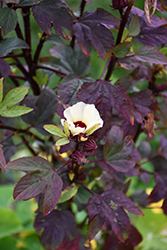It's all about ...
plants

Thai Red Roselle
Hibiscus sabdariffa 'Thai Red'
Height: 4 feet
Spacing: 3 feet
Sunlight:
![]()
![]()
Hardiness Zone: (annual)
Other Names: Florida Cranberry, Thai Red Hibiscus
Description:
Bold and beautiful, this tender perennial turns heads with its red stems, bright red calyces and bold creamy yellow flowers; calyces can be harvested to create zingy teas, sauces, syrups or jams; young leaves are edible with a tangy citrus flavor
Edible Qualities
Thai Red Roselle is an annual herb that is typically grown for its edible qualities, although it does have ornamental merits as well. It produces ruby-red flowers which are typically harvested when mature. The flowers have a tangy taste.
The flowers are most often used in the following ways:
- Eating When Cooked/Prepared
- Preserves
- Sauces
- Tea
Planting & Growing
Thai Red Roselle will grow to be about 4 feet tall at maturity, with a spread of 24 inches. When grown in masses or used as a bedding plant, individual plants should be spaced approximately 3 feet apart. Although it's not a true annual, this fast-growing plant can be expected to behave as an annual in our climate if left outdoors over the winter, usually needing replacement the following year. As such, gardeners should take into consideration that it will perform differently than it would in its native habitat.
This plant is quite ornamental as well as edible, and is as much at home in a landscape or flower garden as it is in a designated herb garden. It does best in full sun to partial shade. It requires an evenly moist well-drained soil for optimal growth, but will die in standing water. This plant should not require much in the way of fertilizing once established, although it may appreciate a shot of general-purpose fertilizer from time to time early in the growing season. It is not particular as to soil pH, but grows best in sandy soils. It is highly tolerant of urban pollution and will even thrive in inner city environments. Consider applying a thick mulch around the root zone in winter to protect it in exposed locations or colder microclimates. This is a selected variety of a species not originally from North America. It can be propagated by cuttings; however, as a cultivated variety, be aware that it may be subject to certain restrictions or prohibitions on propagation.
